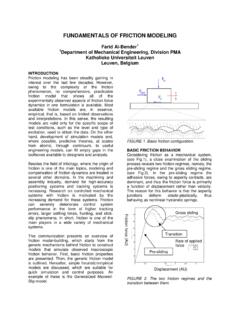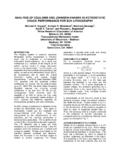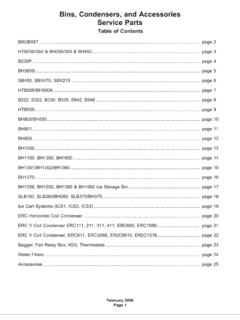Transcription of TEST UNCERTAINTY RATIO (TUR)
1 TEST UNCERTAINTY RATIO (TUR). Samira Khanam, and Edward Morse Center for Precision Metrology University of North Carolina at Charlotte Charlotte, NC, USA. INTRODUCTION DEFINITIONS. Manufacturing industries play a significant role in To understand TUR, it is necessary to know the the economy of many countries over the world, definition of some terms in detail. This paper will including the US. Manufacturing companies' discuss these first: accuracy, bias, precision, success depends on the production of good UNCERTAINTY , and task-specific UNCERTAINTY . quality products. Precise measurement systems are essential to verify the quality of the product. Accuracy (from VIM). Every measurement process contains variations, Accuracy is the closeness of agreement just as each manufacturing process does.
2 Between a measured quantity value and a true Manufacturing variations need to be checked by quantity value of a measurand. the measurement tools. Measurement tools The measurand is a quantity intended to be need to be verified also to insure the best quality measured. The concept measurement of the products. If the variations of the measure- accuracy' is not quantitative and is not given a ment system are high enough, it may affect the numerical quantity value. A measurement is whole manufacturing company, as the cost of said to be more accurate when it offers a smaller poor product quality affects the entire measurement error. manufacturing enterprise. So it is essential for a manufacturing company to have a powerful Bias (from Industry).
3 System to analyze measurement systems. One The bias, or offset, is how we quantify accuracy. such measurement analysis tool is the Test Bias is the difference between the average value UNCERTAINTY RATIO (TUR). of all the measurements ( ) and the true value ( 0). Bias is a measure of the amount by which a Test UNCERTAINTY RATIO (TUR) is the RATIO of the tool is consistently off target from the true value. Tolerance to the UNCERTAINTY for a specific Bias can be positive or negative. measurand. It will provide the information about the accuracy and precision of the system, which Bias = - 0. include repeatability, reproducibility, etc. One purpose of this paper is to give some industrial Because the exact true value is not possible to guidance on how to use TUR.
4 Know, the 'best' estimate of the parameter being measured may be provided by the National Tol. Institute of Standards and Technology (NIST) or TUR = , where U another national metrology institute (NMI). It can be used as a reference value, with a suitably low Tolerance of the product which is in UNCERTAINTY . manufacture's specification, and U= UNCERTAINTY for the specific task. Precision (from VIM). Precision is the closeness of agreement One method of evaluating the expanded between indications or measured quantity measurement UNCERTAINTY for a task is to values obtained by replicate measurements on combine the short-term variability of the system the same or similar objects under specified with a bias of the system, as shown below. conditions.
5 Measurement precision is usually expressed U= |bias| + 2 meas numerically by measures of imprecision, such as standard deviation, variance, or coefficient of It is common to require that the TUR value be variation under the specified conditions of 4:1 or higher, where a larger value of the TUR. measurement. The specified conditions' can corresponds to a better performing measurement system. be, for example, repeatability conditions of for each should be known separately and used measurement. in the appropriate TUR calculation. Measurement UNCERTAINTY (from VIM): Part Tolerance: The tolerance for every task parameter, associated with the result of a needs to known to calculate TUR. In the case measurement, that characterizes the dispersion where one is trying to determine the limiting of the values that could reasonably be attributed tolerance value that can be inspected, this can to the measurand.
6 Be obtained by using the lowest acceptable value of TUR and the task-specific UNCERTAINTY Measurement UNCERTAINTY (from industry): for that measurand. Measurement UNCERTAINTY is a parameter which describes the measured values of a quantity Reference value: The reference value may be which is close to the true value of that quantity. needed to calculate the bias for a particular measurement. The UNCERTAINTY of this value will Task Specific UNCERTAINTY [1]: be lowest if it is obtained from an NMI, but a Task specific UNCERTAINTY is a parameter which is reference value with a suitably low UNCERTAINTY associated with the measured value of a specific from another reliable source is acceptable. task for specific measurement procedure. Environment: Temperature, vibration, dust, etc TUR CONTRIBUTORS may influence the value of UNCERTAINTY .
7 So After knowing the basic definitions of terms, it is these factors need to be taken into consideration important to know the contributors that affect the when measuring the part. TUR, which will help to calculate TUR. Figure 1. shows the contributors to the task specific Measurement Tool: The ability of the UNCERTAINTY , which is necessary to find the TUR. measurement tool to measure the part accurately has the greatest influence on the value of TUR. However, it is a mistake to think Refer- Environ- that this is the only source of UNCERTAINTY . Definition of ence ment task value Measurement set up: If the set up of both the part and the tool is not perfect, the measurement result can be vary. Measurement procedure: One need to use the Part measurement procedure as defined for each Toler- TUR Test measurement tool.
8 Ance -er Software: The measurement results depend on Soft the software, analysis tool of the measurement ware tool. Measure -ment Measure Tester: Test results depend on how expert the Tool -ment Measure tester is. setup -ment procedure The contributors described above have influence on the results of a measurement system. So the Figure 1: Contributors to TUR Task Specific UNCERTAINTY result will be influence by this. As a result TUR value will change. Definition of task: The task needs to be determined first. It may be size, true position or OTHER METRICS. any other characteristic of interest. For every The P/T RATIO is another metric used in the task one need to calculate TUR individually and industries (such as Intel) to find the tolerance need to be determined separately.
9 For measurement capability of the metrology tool. example if one need to calculate TUR for both Below P/T is described and compared with TUR. size and true position, then the tolerance values also to find the reliability of TUR. The P/T RATIO (Industry) values for these tools reveals that Tool C will The capability of the measurement system is give smallest value, and then consequently Tool quantified by computing the P/T (Precision-to- D, Tool B and tool A. Tolerance) RATIO . EXPERIMENTAL COMPARISON. For two-sided specifications (those which have Experiments have been done to compare the both USL and LSL): TUR and P/T RATIO for different measurement tasks. Two blocks, one made of steel and the 6 s ms other of aluminum, were used for these P/T= x100% , calculations.
10 Different numbers of points were USL LSL taken on a circular feature (6, 16 and 30 points), and different numbers of points were taken on where ms=measurement system the datum features. In each case, 4 points were taken on Datum A (the top); and the either 2 or 4. For one-sided specs (those which have either points were taken on Datums B and C (the USL or LSL, or if no spec limits exist): sides). One example of this is shown in Figure 3. 3s ms below. P/T= x100% , TOL. where TOL = (Process Mean or Target LSL). for LSL only, or (USL Process Mean or Target). for USL only. For this measure: Small values of P/T are desirable. P/T 30%: Measurement system capable. P/T > 30%: Measurement system not capable (not precise enough). EXAMPLE. We now give an example comparing the measurement capability of metrology tools.





